Bleeding Red Maple Trees, The Cry After Winter
Bleeding Red Maple Trees, The Cry After Winter
The annual tree pruning of roadside trees in our subdivision started mid January of this year. It was kind of unusual to see that it was done in the winter, but I am no expert to know how it will affect the trees in the future. Apparently the Parks Division in Town of Aurora has two fully trained and experienced municipal arborists on staff, responsible for 90% of our forestry operations, and I guess they will know the procedures.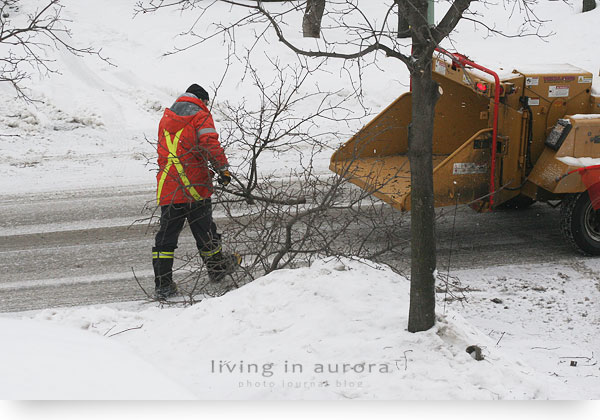
Tree Trimming, Town of Aurora, January 2011
However, I did little research as always. No, I couldn’t really find anything unusual about trimming trees in the winter and especially trimming of the Red Maples – until I noticed this couple of months later.
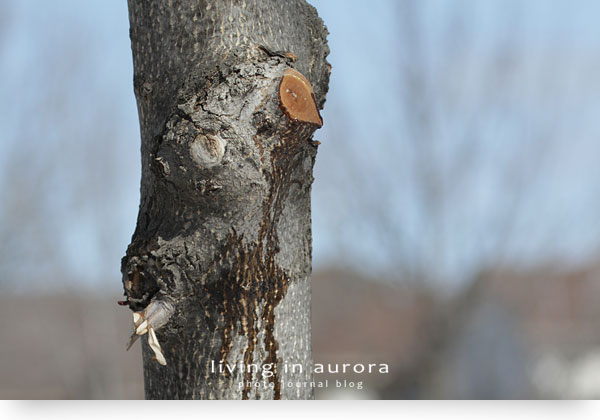
Sap Bleeding Red Maple Tree, Town of Aurora, April 2011
Around mid March of this year I noticed water dripping from the trees. First I thought that it was water from the melting snow that accumulated between the tree trunks, just like melting glaciers on the mountains. No, it was the oozing maple sap. This bleeding process of the maples was carried over to almost mid April. It almost felt like being a part of the Maple Syrup festival, this is how much bleeding there was going on from all the cuts to the Red Maples.
Just Simple Explanation: What Happens In The Maple Tree?
‘Understanding how maple sap is formed requires some knowledge about tree physiology. In the later summer and fall, maple trees virtually stop growing and begin storing excess startches throughtout the sapwood, especially in cells called ray cells. This excess starch remains in storage as long as the wood remains colder than about 40 degrees F. Whenever wood temperatures reach around 40 degrees F, enzymes in the ray cells change to starches to sugars, largely sucrose. This sugar then passes into the tree sap. As the temperatures increase to about 45 degrees F, the enzymes top functioning and sugar is no longer produced. In March and April, the sugar changes back to starch – except during periods of flow. Rising tempeartures creates pressure inside trees, causing sap to flow. When a hole is bored into a tree, wood fibers that are water- (sap-) carrying vessels are severed, so sap drips out of the tree.’
Source: The University of Maine Cooperative Extension
According to more of my Internet research elm, maple, walnut and birch will bleed sap when pruned in the later winter to early spring. We don’t have to worry too much as we don’t park cars directly under the trees, but the sap can drip on cars and sidewalks. I also tried to find if the oozing sap is harmful to the trees, and some think that the bleeding sap can interfere with the closure of pruning cuts. What is the alternative then? Trim trees in the fall, but then fall is least desirable because cuts close more slowly than in any other seasons. Another source says to trim plants with a high sap flow in the late spring or early summer.
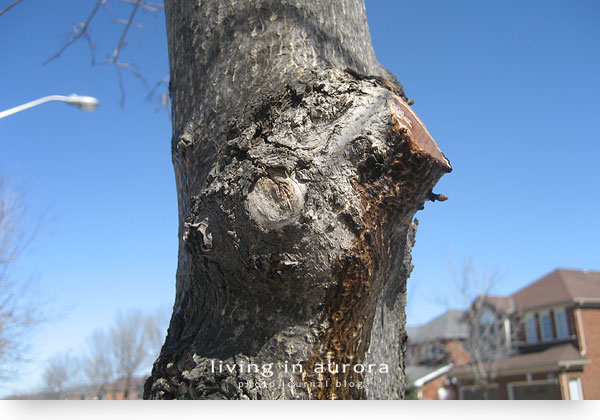
Sap Bleeding Red Maple Tree, Town of Aurora, March 2011
To conclude, no worries – tree trimming should be fine in the winter as I couldn’t find any warnings. Well, if it is not, I will let you know, as I will be watching my maple tree. I hope nothing happes, because it is now a very good size tree to provide shade for the grass and walkers.
- Bleeding Maple Tree, Town of Aurora, March 2011
- Sap Bleeding Red Maple Tree, Town of Aurora, April 2011
- Tree Trimming, Town of Aurora, January 2011

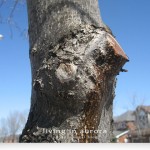
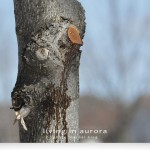
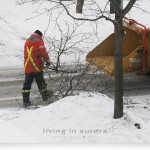








June 13, 2011 at 22:08
When they came to trim our tree this year, I ran out to find out what was going on. I love to see a full tree and had hoped they would leave mine intact since it is so young, especially in a relatively new suburb. I was told that they were instructed to prune any branches that are crossing over, or low growing. Quite a few of mine got lopped off. My main concern was if the wound from pruning leaves the tree succeptable to insect infestation or if they should be treating the open spot with some sort of sealant to ensure that boring insects woudn’t be able to easily infest the trees. I have no idea. I took pictures at the time also!
June 14, 2011 at 01:09
Butterfly, you are brave to just ask them like that.
It should be okay, but they definitely cut some big branches too, and to have a good point.
Anna